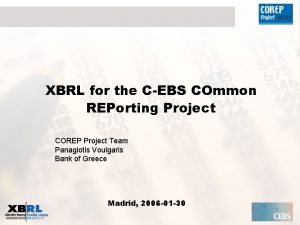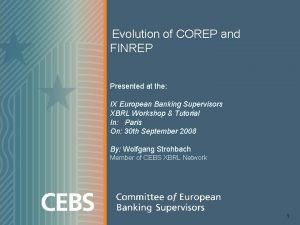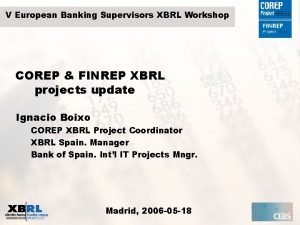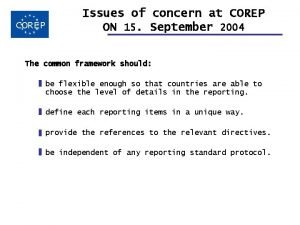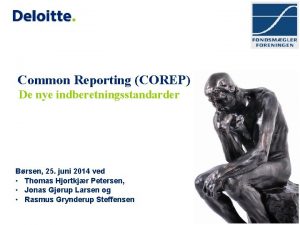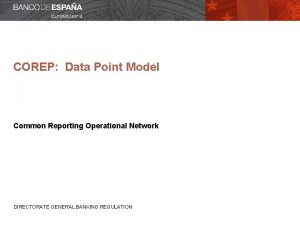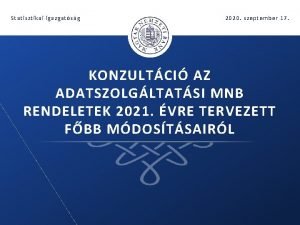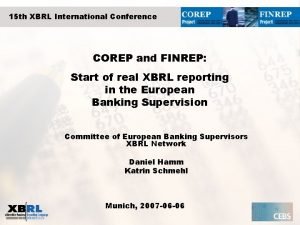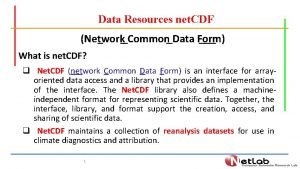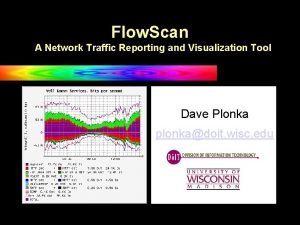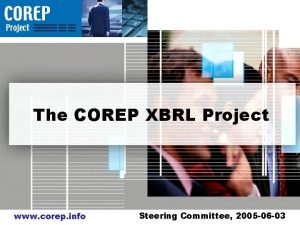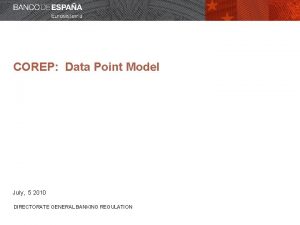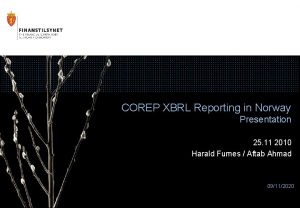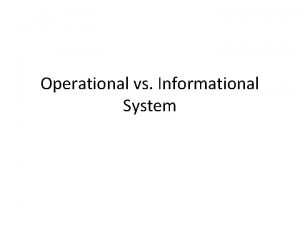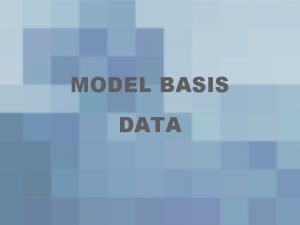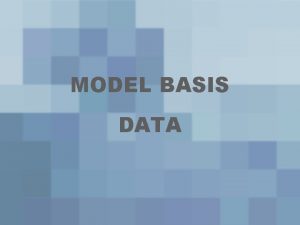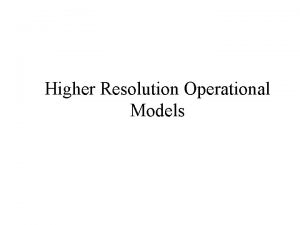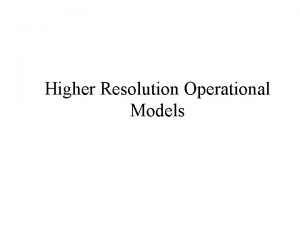COREP Data Point Model Common Reporting Operational Network










![COREP: REST OF DOMAINS (DOM) (2/2) DOM: PERCENTAGE INTERVAL Risk weights [CR SA]: 0%, COREP: REST OF DOMAINS (DOM) (2/2) DOM: PERCENTAGE INTERVAL Risk weights [CR SA]: 0%,](https://slidetodoc.com/presentation_image/f4f0d471d7ce1876b098bf6a9795b000/image-11.jpg)




- Slides: 15

COREP: Data Point Model Common Reporting Operational Network DIRECTORATE GENERAL BANKING REGULATION

INTRODUCTION ‘Data point model (DPM)’ - It is a systematic representation of the data of a reporting framework. - It represents every single data (cell) of the reporting tables using the values of the “Base” and “Dimensions” that characterize them. [See next slide] - It does not add or delete any of the cells of the tables. These are simple presentations of several data points. - It facilitates the development of any IT Taxonomy. Initial purpose of a DPM for COREP - To have a “Base” and “Dimensions” that are consistent from a conceptual (prudential) point of view and easily understandable from the business side. - To use the same approach already used for CEBS: • The number of dimensions should be the strictly necessary. • To use the same domains/dimensions as in FINREP DPM when they refer to the same concepts. DG BANKING REGULATION 2

IDENTIFICATION OF A DATA POINT (CELL) A data point (cell) is represented using the values of the “Base” and “Domains/Dimensions” that characterize it. The same data point is defined only once, regardless whether it is included or not in more than one table. BASE Basic [financial/supervisory/statistical] meaning (nature) of the data from a conceptual point of view (e. g. Capital requirements: OPR) DOMAIN: Family of different “dimensions” that have similar nature (e. g. Main category) DIMENSION Each of the different “characteristics” that identify the information included in a data point (e. g. Types of exposure). Every “dimension” must have two or more values (members). It is possible to use more than one “dimension” of a “domain” to identify a data point (cell) (e. g. Business lines, Event types – losses). It is not possible to use more than one “member” of a “dimension” to identify a data point (cell). MEMBER Each “value” that can have a dimension (e. g. Corporate finance). A “member” can be used in more than a dimension when it has the same meaning (e. g. the member 0% is used in several dimensions of the domain “Percentage interval”). DG BANKING REGULATION 3

COREP: BASE Basic meaning (nature) of every data point from a supervisory point of view - Own funds for solvency purposes [CA] - Capital requirements - Credit risk and settlement/delivery risk [GS] Credit risk (Credit, counterparty credit and dilution risks and free delivery) [CA, CR] Settlement/delivery risk [CA, CR TB SETT] - Market risk (Position, foreign exchange and commodities risks ) [CA, MKR] - Operational risk [CA, OPR] - Fixed overheads [CA] - Other and transitional capital requirements [CA] - Memorandum items [CA] DG BANKING REGULATION 4

COREP: DOMAINS Key Domains - Main category - Amount type For capital requirements also: - Portfolio - Approach to capital requirements - Exposure classes (for credit risk) - Risk type (for market risk) Rest of Domains - Credit risk mitigation/(Collateral/guarantees) - Currency - Geographical area - Impaired / Unimpaired - Percentage interval - Securitization - Time interval DG BANKING REGULATION 5

COREP: MAIN CATEGORY indicates the specific meaning of the data. CLASSIFICATION CRITERIA By- (detailed) nature of the data DIMENSIONS: - Own funds for solvency purposes [CA, GS]: Total own funds, Original own funds, Eligible Capital, … - Contribution to own funds [GS]: Total, of which. … - Capital requirements [CA]: Total, of which: Investment firms under article … - Type of exposure [CR and MKR]: Total exposures, On balance sheet items, Off balance sheet items, … - Operational risk [Business lines] [OPR and OPR Details]: Corporate finance, Trading and sales, . . . - Operational risk [Event types - losses] [OPR Details]: Internal fraud, External fraud, … - Operational risk [Threshold applied in data collection] [OPR]: Lowest, Highest - Other and transitional capital requirements [CA]: Complements to overall floor for capital requirements, … - Assets [OPR]: Loans and advances - Comprehensive income [OPR]: Gross income - Contribution to own funds [GS]: Total, of which: … - Memorandum items [CA]: IRB provision excess (+) / shortfall (-), Solvency ratio (%), … DG BANKING REGULATION 6

COREP: AMOUNT TYPE identifies the class of amount reported for the main category of the data. Examples of amount types for: - Own funds for solvency purposes [CA]: Outstanding - Capital requirements [CA]: Capital requirements - Memorandum items [CA]: Outstanding, Percentage (%) - Credit risk [CR] : Original exposure pre conversion factors, Value adjustments and provisions, Capital requirements, PD (%), . . . - Settlement / Delivery risk [CR TB SETT] : Capital requirements, Settlement price, … - Market risk [MKR]: Capital requirements, All position (long, short), Net positions, Previous day Va. R, … - Operational risk [OPR Details]: Capital requirements, Number of events, Total (gross) loss, … - Contribution to own funds [GS]: Contribution DG BANKING REGULATION 7

COREP: PORFOLIO AND APPROACH DOM: PORTFOLIO - Prudential portfolios: All books, Banking book, Trading book DOM: APPROACH TO CAPITAL REQUIREMENTS - Credit risk [CR] : SA, SEC SA (Rated, Unrated), IRB (non own estimates, own estimates), SEC IRB - Market risk [MKR]: SA (General risk, Specific risk, …), IM (GR, SR) - Operational risk [OPR]: BIA, TSA, AMA - IRB approaches for credit risk [CR IRB]: Exposures assigned to obligor grades or pools, … DG BANKING REGULATION 8

COREP: EXPOSURE CLASSES AND RISK TYPE DOM: EXPOSURE CLASSES - Standardised approach (CR SA Total): Central Governments or central banks, … - Standardised approach (CR SA Details): General Government, Institutions, Corporates, Retail [This dimension could be necessary if the definitions of the members are wider than in CR Total] - IRB approach [CR IRB]: Central Governments and central banks, … - Assessment by a nominated ECAI [CR SA]: Without credit assessment DOM: RISK TYPE - Market risk types (MKR): Traded Debt Instruments, Equities, Foreign Exchange, Commodities DG BANKING REGULATION 9

COREP: REST OF DOMAINS (DOM) (1/2) DOM: COLLATERAL/GUARANTEES (CREDIT RISK MITIGATION) - Credit Risk Mitigation (Type of credit protection) [CR]: Unfunded credit protection (guarantees/credit derivatives), Funded credit protection (financial collateral, …) - Credit Risk Mitigation [Method applied] [CR]: Substitution effect, Comprehensive method, … DOM: CURRENCY - Currency of the instrument [MKR TDI/FX]: ISO code (4217) - Currency positions [MKR SA FX]: Currency 1, 2, …, 10 DOM: GEOGRAPHICAL AREA - Country code [CR IRB and MKR SA EQU]: ISO code (3166 -2) - Country of origin of exposures assigned to obligor grades or pools [CR IRB]: Country with most exposures, … - National market of equity instruments [CR EQU IRB]: ISO code (3166 -2) DOM: IMPAIRED/UNIMPAIRED. - Default for prudential purposes [CR IRB]: Non - defaulted exposures - Transactions unsettled [CR TB SETT]: Up to 4 days (Factor 0%), … DG BANKING REGULATION 10
![COREP REST OF DOMAINS DOM 22 DOM PERCENTAGE INTERVAL Risk weights CR SA 0 COREP: REST OF DOMAINS (DOM) (2/2) DOM: PERCENTAGE INTERVAL Risk weights [CR SA]: 0%,](https://slidetodoc.com/presentation_image/f4f0d471d7ce1876b098bf6a9795b000/image-11.jpg)
COREP: REST OF DOMAINS (DOM) (2/2) DOM: PERCENTAGE INTERVAL Risk weights [CR SA]: 0%, 10%, … Risk weights [CR IRB: Specialized lending slotting criteria]: 0%, 50%, … Risk weight (CR EQU IRB: Simple risk weight): 190%, … Conversion factors of off-balance sheet items [CR SA]: 0%, 20%, … Conversion factors of off-balance sheet items [CR SEC SA/IRB]: 0%, > 0% and ≤ 20%, … DOM: SECURITIZATION [CR SEC] Securitization type: Traditional, Synthetic Securitisation: Securitised exposures, Securitisation exposures originated, Securitization position, … Tranche: Senior, Mezzanine, First loss Roll of the reporting institution: Originator, Sponsor, Investor Originators and sponsors involvement: Entities not complying with the retention requirement Early amortization provisions: Early amortization Rated (credit quality steps)[at inception] [CR SA]: CQS 1, … Rated (amount quality steps)[at reporting date] [CR SA]: CQS 1, … Rating based approach [at inception] [CR IRB]: CQS 1 & S/T CQS 1, … Rating based approach [at reporting date] [CR IRB]: CQS 1 & S/T CQS 1, . . . DOM: TIME INTERVAL Remaining maturity [MKR SA TDI]: 0 ≤ 1 months, > 1 ≤ 3 months, . . . Modified duration [MKR SA TDI: Duration based approach]: Zone 1 [≤ 1 year], … Financial year [OPR]: Year – 3, Year – 2, Last year DG BANKING REGULATION 11

EXAMPLE 1. Simplified CA Table ID LABEL 0010 1 TOTAL OWN FUNDS FOR SOLVENCY PURPOSES 1270 1. 8 MEMORANDUM ITEMS 1. 8. 1 IRB provision excess (+) / shortfall (-) 2 CAPITAL REQUIREMENTS 2. 1. 1. 1. 01 Central Goverments or Central Banks 1420 MEMORANDUM ITEMS 1980 3. 2. a Solvency ratio (%) Cells Base Main category Portfolio Approach Exposure class Amount type 0010 Own funds for solvency purposes Own funds: Total own funds Outstanding 1270 Memorandum items: Memorandum item IRB provision excess (+)/ shortfall (-) Outstanding 1420 Capital requirements: Credit risk Type of exposure: Total exposures Banking book Credit risk: SA SA approach: Central Government or Central Bank Capital requirement 1980 Memorandum items: Solvency ratio (%) Percentage DG BANKING REGULATION 12

EXAMPLE 2. Simplified CR SA Total table (I) CR SA Total CREDIT AND COUNTERPARTY CREDIT RISKS AND FREE DELIVERIES: STANDARDISED APPROACH TO CAPITAL REQUIREMENTS ORIGINAL EXPOSURE CREDIT RISK MITIGATION (CRM) PRE CONVERSION TECHNIQUES WITH SUBSTITUTION EFFECTS FACTORS ON THE EXPOSURE FULLY ADJUSTED EXPOSURE VALUE (E*) UNFUNDED CREDIT PROTECTION: ADJUSTED VALUES (Ga) GUARANTEES CREDIT DERIVATIVES 40 50 BREAKDOWN OF THE FULLY ADJUSTED EXPOSURE OF OFFBALANCE SHEET ITEMS BY CONVERSION FACTORS Breakdown of expousre value by risk weights CAPITAL REQUIREMENTS EXPOSURE VALUE 100% 75% 180=130 -140 - 10 130 170 10 260 330 0, 8*150 -0, 5*160 TOTAL EXPOSURES Cell linked to CA BREAKDOWN OF TOTAL EXPOSURES BY EXPOSURE TYPES: 20 On balance sheet exposures subject to credit risk 30 Off balance sheet exposures subject to credit risk Cell linked to CA BREAKDOWN OF TOTAL EXPOSURES BY RISK WEIGHTS: 70 0% 240 BREAKDOWN OF TOTAL EXPOSURES BY EXPOSURE CLASSES: Central governments or central banks DG BANKING REGULATION 13

EXAMPLE 2. Simplified CR SA Total table (II) Cells Base Main category Portfolio Approach Exposure class Amount type CRM Risk weight 240/330 Capital requirements: Type of exposure: Credit risk Total exposures Banking book Credif risk: SA SA approach: Central Govern. or Central Bank Capital requirements _____ 010/010 Capital requirements: Type of exposure: Credit risk Total exposures Banking book Credif risk: SA SA approach: All Original exposure pre conversion factors _____ 020/040 Capital requirements: Type of exposure: Credit risk On balance sheet Banking book Credif risk: SA SA approach: Prud. Port: Adjusted value (Ga) All Guarantee 240/170 Capital requirements: Type of exposure: Credit risk Off balance sheet Banking book Credif risk: SA SA approach: Central Govern. or Central Bank Fully adjusted exposure _____ Conversion factor (CR SA): 100% 030/260 Capital requirements: Type of exposure: Credit risk Off balance sheet Banking book Credif risk: SA SA approach: All Exposure value _____ Risk weight (CR SA): 75% 070/010 Capital requirements: Type of exposure: Credit risk Total exposures Banking book Credif risk: SA SA approach: All Original exposure pre conversion factor _____ DG BANKING REGULATION 14

THANK YOU FOR YOUR ATTENTION Address for comments: carlosj. rodriguez@bde. es; luis. gutierrezderozas@bde. es DIRECTORATE GENERAL BANKING REGULATION
 Common reporting corep
Common reporting corep What is corep
What is corep Corep
Corep Corep templates
Corep templates Corep
Corep Corep
Corep Corep template
Corep template Corep meaning
Corep meaning Corep c34
Corep c34 Corep club login
Corep club login Corep e finrep
Corep e finrep Operational and informational data store in data warehouse
Operational and informational data store in data warehouse Operational data vs decision support data
Operational data vs decision support data Ncdisp
Ncdisp Network flow visualization tool
Network flow visualization tool Balkan investigative reporting network
Balkan investigative reporting network
